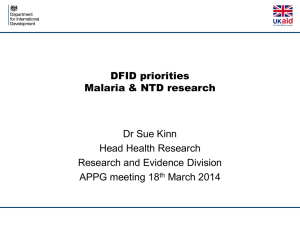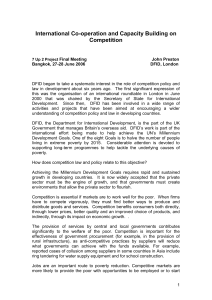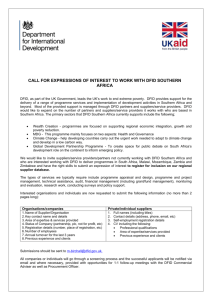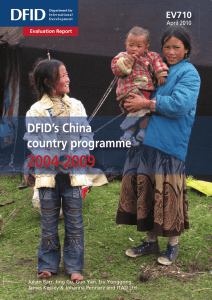Competition Policy, Growth and Poverty Reduction CUTS’ 7Up4 Launch Conference
advertisement
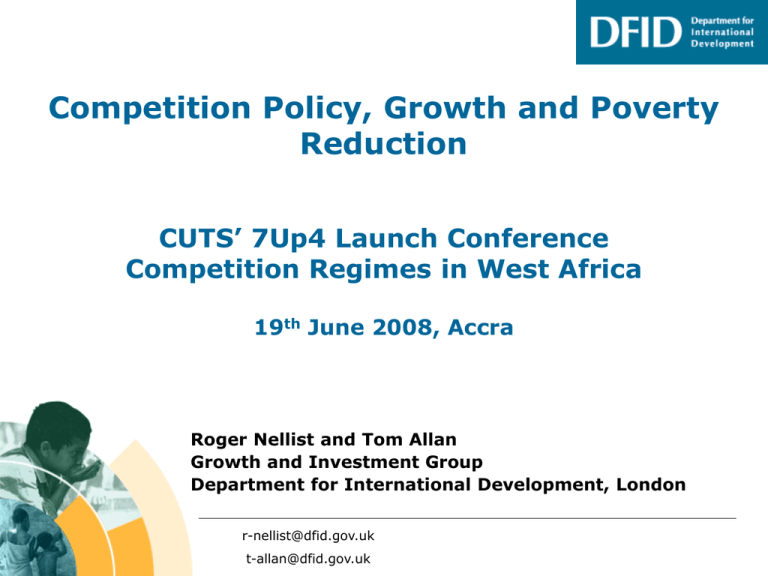
Competition Policy, Growth and Poverty Reduction CUTS’ 7Up4 Launch Conference Competition Regimes in West Africa 19th June 2008, Accra Roger Nellist and Tom Allan Growth and Investment Group Department for International Development, London r-nellist@dfid.gov.uk t-allan@dfid.gov.uk Themes • Reflections and Overview of linkages • Competition links with Growth (inc • • • • • Investment Climate) Competition links with Poverty Reduction Competition abuses in Africa and elsewhere Challenges Competition Assessment Framework Conclusions Page 2 Reflections on Competition • Competition is the process of rivalry between firms striving to gain sales and make profits • Major concept, but cannot be measured directly • Competition is a process and not an ‘equilibrium event’; it is not automatic; markets can fail (forces at work against); needs to be promoted, nurtured and protected • Competition, vs. fair competition • Culture of competition Page 3 Overview of Linkages CP -> Competition -> PSD -> Growth -> Poverty reduction and/or CP (via business behavioural changes) -> Poverty reduction (consumer welfare) [Efficiency and Equity] Page 4 Competitive Markets Essential for Growth – Basic Premises • Fair and effective competition - and competition policy - is fundamental to the functioning of a modern market economy • Efficient, fair markets essential to catalyse private sector development and growth • Competition drives innovation and productivity improvements; these drive economic growth Page 5 Commission on Growth Development • Growth Report, launched May 2008: High level Commission chaired by Professor Michael Spence, a Nobel Laureate in Economics • ‘Dynamic productivity gains from entry and exit can overwhelm the static efficiency gains from scale’ • ‘Structural change under competitive pressure is what propels productivity growth’ • Policy recommendation: ‘Governments need to increase competition and flexibility in product and labour markets’ Page 6 Some Economics: Production Function and Growth • Cobb-Douglas: Y AK L • Endogenous growth theory: long run economic growth depends on rate of technical change • Production Possibility Frontier moves out with enhancements in innovation and productivity Page 7 Production Possibility Frontier K Output increases with innovation and productivity enhancements, for any given level of K, L inputs PPF² PPF¹ L Page 8 More Competitive Pressure, More Innovation - Evidence • Firm-level surveys confirm the importance of competitive pressure for incentives to innovative and increase productivity Source: WDR, 2005 Page 9 Competition – what it means in practice • Fair, effective competition creates level • • • • playing field for domestic SMEs (livelihoods, firms and jobs, globalisation) Free entry and exit - innovation, technology, productivity Intermediate inputs Links with international competitiveness More effective competition also limits corruption Page 10 Private Investment Has Grown Faster in Countries with Better Investment Climates Source: WDR, 2005 Average 1984-2000 based on International Country Risk Guide’s index of “Investment Profile” Page 11 Links with Poverty Reduction • Direct benefits - fair competition enhances consumer welfare (prices, choice, standards?); essential private goods and services consumed by poor. • Competition introduced in sanitation services in Tanzania – lower charges and increased access • Competition introduced in generic drugs in South Africa – prices for antiretroviral drugs fell by up to 88% since 2003 and access increased from 20,000 to 155,000 Page 12 Links with Poverty Reduction • Indirect benefits through: - general growth enhancements; - access to sustainable livelihoods in formal sector (shared growth, MMW4P); • Publicly provided infrastructure and services (Govt procurement arrangements, and bid rigging) • Study of IDA countries: the world’s poorest countries tend to have low levels of competition in domestic markets and a high degree of market dominance (FIAS, 2007) Page 13 Competition abuses hurt consumers “People of the same trade seldom meet together, even for merriment or diversion, but the conversation ends in a conspiracy against the public, or in some contrivance to raise prices” Adam Smith, The Wealth of Nations, 1776 “The ‘really big’ distortions to competition are in poor countries” W. Lewis (2004) The Power of Productivity Page 14 Competition Abuses in Africa • A study of media reports in sub-Saharan Africa identified allegations of 617 anticompetitive practices between 1995 and 2004, in 41 business sectors and in 34 countries. • Harm to consumers and businesses • The food and beverage sector received the most allegations (148) – high prices in this sector have a direct impact on the welfare of the poor, who spend a higher proportion of their income on necessities like food. [Evenett, Jenny, and Meir, 2006] Page 15 Competition Abuses in Africa – other examples • Commission for Africa Report 2005 - Role of competition policy in investment climate - Examples of low competition’s impact: transport costs • Distortions include: (1) Private sector misconduct e.g. insurance, alcoholic beverages in Kenya, transport cartels (2) Privatization can create private monopolies e.g. Uganda (3) ‘Subsidies’ for SOEs e.g. Telecoms in Zambia (4) Alleged vested interests e.g. competition law in Egypt Page 16 Legislative Barriers often a Major Impediment to Competition: Many kinds, but entry barriers particularly serious Starting a Business Africa Number of Procedures 11 8 8 Time in days 64 53 35 Cost (% Nat. Inc.) 215 43 40 Minimum Capital (% Nat. Inc.) 297 110 1 E.Asia S.Asia * Adapted from Broadman (2007), figures rounded Page 17 Competition policy is important everywhere • ‘Strong competition policy is not just a luxury to be enjoyed by rich countries, but a real necessity for those striving to create democratic market economies’, Joseph Stiglitz, Nobel Prize Winner Page 18 Challenges for developing competition policy • Difficulties in assessing the evidence: relationships, data, and measurement • Lack of community awareness of the effects of limited competition • Small/vulnerable DC markets • Capacity constraints Page 19 Challenges of implementation • Lack of coordination between competition • • • • authorities and other government agencies Potential conflict with other policy objectives Persistence of natural monopolies and tension with sector-specific regulators Resistance from vested interests Lower priority and lack of political will Page 20 DFID’s Competition Assessment Framework (2008) • Flexible diagnostic tool for policy makers • Holistic approach, reflecting multiple causes of limited competition • Sequential set of questions • Annexes highlighting key competition issues in particular sectors Page 21 The CAF approach: a brief summary • Poses sets of questions grouped by theme • Select sectors important to economy or consumers, • • • • where some indication of possible problems (e.g. high concentration, high entry barriers) Identify relevant markets and market structures Do Government policies hinder competition? (all levels of government, regulated sectors, trade and industrial policy, unequal enforcement of laws) Identify vested interests Look for signs of anti-competitive conduct by firms Page 22 CAF: Draw Conclusions Is competition in relevant markets weak? • If so, what are the effects? • Who profits? • Who loses? • What corrective action is possible? (Depends on local laws and institutions.) • What are the likely effects of corrective action on the economy? (e.g. on investment, productivity, employment, exports?) Page 23 Uses of the CAF • Developed as side product of continuing • • • • • DFID-WBG (FIAS) competition programme in India with CCI Africa Regional Workshops – Tanzania (Jan08), Botswana (Feb 08) India, Bangladesh (March 08) Vietnam, ++ (2008) ODI Competition Research Programme into state of competition in Africa and Asia (2008 – 2009) Growth analytics and MMW4P Page 24 Competition Assessment Framework (2008) • Downloadable at: http://www.dfid.gov.uk/pubs/files/caf2008.pdf Roger Nellist, Head Tom Allan, Economist Growth and Investment Group Department for International Development London r-nellist@dfid.gov.uk t-allan@dfid.gov.uk Page 25 Conclusions • Fair competition matters for: - stimulating growth (innovation and productivity) - entrepreneurs (SMEs) to enter/expand market - wealth creation, poverty reduction • It matters in Africa!! • Successful CP needs: - pro-market commitment from top bottom-up advocacy, and culture of competition appropriate policies, laws, institutions technical capability, financial resources operational independence • Beware of vested interests, that block reforms • Assess and address the real impediments to competition Page 26
